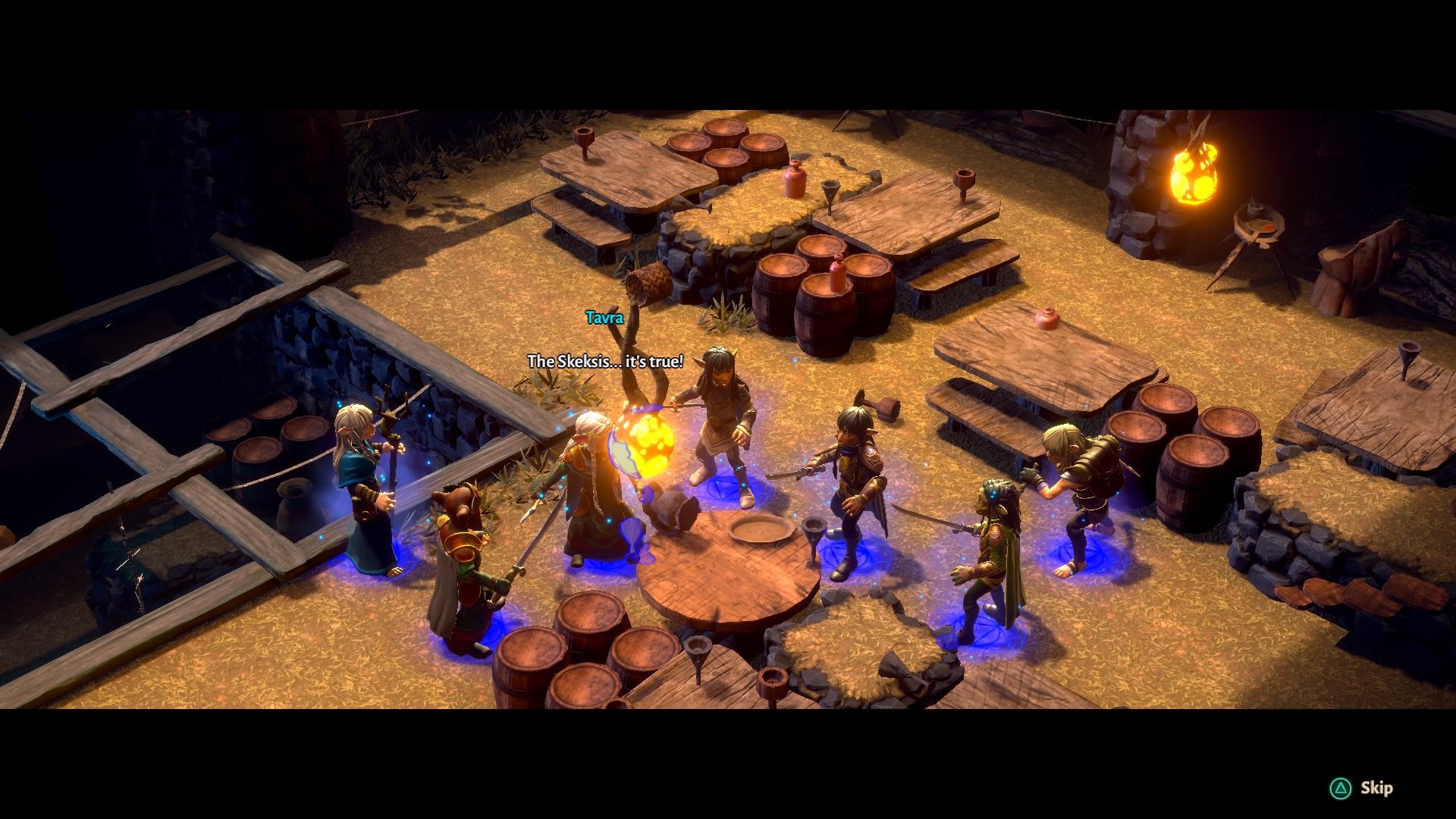A few years ago, if you told me that The Dark Crystal would be getting a revival on Netflix, I would’ve laughed in your face. If you’d went one step further and told me that the same franchise would be getting its own PS4 game, I would’ve suggested gettin your head examined. Yet here we are, on the precipice of the The Dark Crystal: Age of Resistance Tactics’ release, and I still can’t believe the extent that the brand has been able to revive itself, nearly 40 years after its initial release. Can the game manage to hold up under the scrutiny that comes with nostalgic memories, or will it crumble under the weight of the audience’s expectations?
Back to the Beginning
The recent Netflix series has opted to go the prequel route, and as such, The Dark Crystal: Age of Resistance Tactics is taking a similar tack. Recycling characters from the original incarnation, along with a bevy of newcomers from the series, the title runs concurrently with the television narrative, without necessarily telling the same story. There are several key elements that are alluded to in the show, but are never actually shown. These breadcrumbs and side-explorations from the series form the game’s narrative backbone. It can both stand on its own, as well as further flesh out the universe.
Personally, I was very fortunate that the storyline was designed without the necessity of an encyclopedic knowledge of Henson’s seminal IP. Here’s a dirty little secret for you: I’ve never seen the film or the series. Yet, without missing a beat, I was easily able to become invested in the oddball characters and interweaving storylines that are simultaneously taking place throughout the world.

A vast majority of the plot plays out in the form of graphic novel inspired cinematics. Individual frames from a page will fade in and out, while written dialog and key story points are explicitly spelled out in words. That’s right folks! You are going to need to actually read words on a screen. Despite the Netflix series having a stellar voice cast, including the likes of Mark Hamill, Simon Pegg, Eddie Izzard, and Taron Egerton, not a single one of them lend their dulcet tones to this title. Narrative development is a text-only affair, and while that isn’t necessarily a showstopper, it certainly proves to be a bit of a disappointment given the weight of the IP it is backing.
Once the core gameplay takes center stage, the narrative ultimately takes a backseat in favor of well-designed tactics action. This will likely come as a surprise to no one, but with a focus on primarily combat, there isn’t much room for a verbose narrative between sword-slashes and defensive spells. Most of the exposition occurs almost entirely before or after battle, with the occasional dialog bubble mixed-in mid-conflict, when some sort of shift in a battle takes place. These sorts of interruptions can take the form of anything from new environmental effects to additional adversaries entering the arena.
Enchantingly Straightforward
As far as the actual tactical gameplay is concerned, the core mechanics don’t really stray too far from what you’d expect. A series of objectives of varying levels of difficulty are displayed in the top-right hand corner of the screen and once these requirements have been met, the stage is cleared. Most of the time players will be tasked with clearing all enemies from the arena, defeating a singular boss-type character or reaching a key position on the map with two to three party members. There are a handful of stages that have a mid-battle plot twist that potentially introduces a new goal or two, but for the most part, this entire process is fairly cut-and-dry.
Tactics fans will be quick to point out that one of the biggest elements at play in any conflict is the juxtaposition of different character skillsets and arsenals, scattered throughout the battlefield. Each party member is initially assigned to one of three key job classes: Mender, Scout, or Soldier. Over the course of the campaign there are opportunities to shift from these pre-designated classes. However, by the time someone has leveled up enough to pivot jobs, it becomes difficult to justify making that abrupt of a change. This is partially due to the fact that shifting jobs will reset the leveling counter back to 1, which renders the decision a moot point unless you are a masochistic fan of merciless level-grinding.

Each primary, and later secondary, job also has its own sub-jobs that will begin leveling back at one when choosing to graduate to a new class. For example, once a solder reaches level 10 there is an opportunity to advance that unit to either a Paladin or Stone Warden. The primary difference between the two is that one is more defensively minded, while the other gravitates more towards the offensive side.
The reason to focus on leveling up the job tree is for the specific abilities that each new role can unlock in battle. A standard soldier has the option to use variations on a garden-variety “hit the beaky-looking bastard standing directly in front of you” strikes. On the other hand, Paladins have the ability to execute double strikes, attacks that also damage enemies in adjacent squares, or even the chance to automatically execute counter-attacks to incoming melee strikes. While this is a very basic example, each core job has up to three additional sub-jobs to explore. It’s highly worthwhile to dig around and find a skillset that best lines up with a party member’s physical capabilities.
Gearing Up for Success
One last wrinkle to the customization of characters is their equipment. Most units have up to three different slots consisting of a weapon, armor, and trinket. These items will be dropped after a stage’s completion on a semi-frequent basis, but are far more regularly purchased using the in-game currency of pearls. Through upgrading the gear of your favorite combatants, their respective skills can be artificially augmented, resulting in the boosting of a weaker unit’s abilities or taking a more dominant unit to the next level.
In execution, the introduction of new pieces of gear kicks off a hand-me-down process, much like I remember occurring in my house as a child. Every time I purchased a new version of the Game Boy, I would take my old handheld and give it to my younger brother. He would then give his handheld to our other younger brother, and so on… The same is the case when uncovering or buying a sweet new piece of gear, which kicks off a similar process amongst my party members. Unfortunately, this would hit a bit of a hiccup at the bottom of the food chain, because as far as I could tell, there was no way to sell the lowest common denominator. These poor, neglected items just sat in the inventory forever, gathering dust on the “Island of Misfit Gear” instead of being cashed in towards the purchase of additional upper-tier items.

Jobs, abilities, and equipment all contributed towards the meta-game of building a core squad that could topple any scenario that the campaign could dish out. While this sounds great on paper, it did introduce a handful of issues. For one, it was impossible to plan before a battle, aside from knowing what units were required for a given stage. There are no indicators of the types of adversaries in the upcoming encounter or environmental variations that might be at play. Essentially these handful of factors had to be adjusted to on the fly, or risk receiving your ass in a take-out bag. Fortunately, there were no dire consequences to failure, aside from the need to replay a mission. Also, it’s worth noting that perma-death isn’t at play here, so feel free to experiment with scenarios to your heart’s content.
It’s highly unlikely that The Dark Crystal: Age of Resistance Tactics is going to be winning any awards for originality or genre-defining evolutions. That said, it’s a perfectly competent tactics experience, set in a world that many have grown to love. If you’re looking for solid gameplay mechanics, featuring an interesting narrative and meaty campaign, this may be just what the Mender ordered.
The Dark Crystal: Age of Resistance Tactics review code provided by publisher. Reviewed on a launch PS4. For more information on scoring, please read our Review Policy.
-
Features a storyline that compliments the series without retreading it
-
Experimenting with job trees and abilities can be addicting
-
Tactics mechanics are solid and predictable
-
Party members tend to re-use/re-skin character models
-
None of the series voice actors reprise their roles
-
Stage designs tend to be a bit repetitive and bland
-
More mission objectives variety would've been nice








